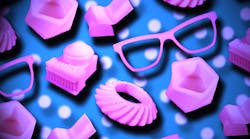Engineers at the Massachusetts Institute of Technology (MIT) leveraged funding from Lockheed Martin Corp. to develop a desktop 3-D printer that performs up to 10 times faster than existing commercial counterparts. So while most common printers can turn out a few Lego-sized bricks in an hour, the MIT printer can turn them out in just a few minutes.
The key to the printer’s speed lies in its compact printhead. It contains two new, speed-enhancing components: a screw mechanism that feeds polymer material through a nozzle with considerable force; and a laser that rapidly heats and melts the polymer, letting it flow quickly through the nozzle. This is an important step in making 3D printing feasible for economical widespread production.
“If I can get a prototype part—maybe a bracket or a gear—in 5 to 10 minutes rather than an hour, or a bigger part over my lunch break rather than the next day, I can design, build, and test faster,” says Professor John Hart, director of MIT’s Laboratory for Manufacturing and Productivity and the Mechanosynthesis Group. “If I’m a repair technician and had a fast 3D printer in my vehicle, I could 3D-print a repair part on-demand after I figure out what’s broken. I don’t have to go to a warehouse and take it out of inventory.” Hart adds that he envisions applications in emergency medicine and for a variety of needs in remote locations.
The MIT team had previously calculated that commercial desktop extrusion 3D printers, on average, print at a rate of about 20 cubic centimeters (or several Lego bricks’ worth of structures) per hour. It also identified three factors limiting printer speed: how fast a printer moves its printhead, how much force a printhead uses to push material through the nozzle, and how quickly the printhead can melt a material and make it flow.
In most desktop 3D printers, plastic gets fed through a nozzle via a “pinchwheel” mechanism, in which two small wheels within turn and push the plastic, or filament, forward. This works well at relatively slow speeds, but if more force is applied to speed up the process, the wheels soon lose their grip on the material. This limits how fast the printhead can push material through.
The design team eliminated the pinchwheel design, replacing it with a screw mechanism that turns and contacts a larger surface area then a pinchwheel. So a textured plastic filament is fed onto the screw. As it turns, it grips the filament’s textured surface and feeds the filament through the nozzle at higher forces—up to 10 times greater than conventional printers—and speeds.
The team added a laser downstream of the screw to quickly heat and melt the filament before it passes through the nozzle. So the plastic is more quickly and thoroughly melted, compared with conventional 3D printers, which use conduction to heat the walls of the nozzle to melt the extruding plastic. By adjusting the laser’s power and turning it quickly on and off, the team could control the amount of heat delivered to the plastic. Both the laser and the screw mechanism were included in a custom-built printhead about the size of a computer mouse.
Finally, the team devised a high-speed gantry mechanism, an H-shaped frame powered by two motors and connected to a motion stage holding the printhead. The gantry moves nimbly between several positions and planes so that the entire printhead moves fast enough to keep up with the extruding plastic’s faster feeds.
During testing, the team ran into a small glitch in their speedier design: Extruded plastic is fed through the nozzle at such high forces and temperatures that a printed layer can still be slightly molten when the printer starts extruding a second layer. That means the team will have to figure out a way to actively cool the part as it prints so it retains the proper shape and doesn’t get distorted or soften.
The team will also be looking to improve the filament’s path through the printhead and is exploring new materials such as high-strength polymers and composites that will be compatible with the printhead. Another avenue of R&D will revolve around building larger-scale 3D printers that can build bigger structures for tooling, or even furniture.

